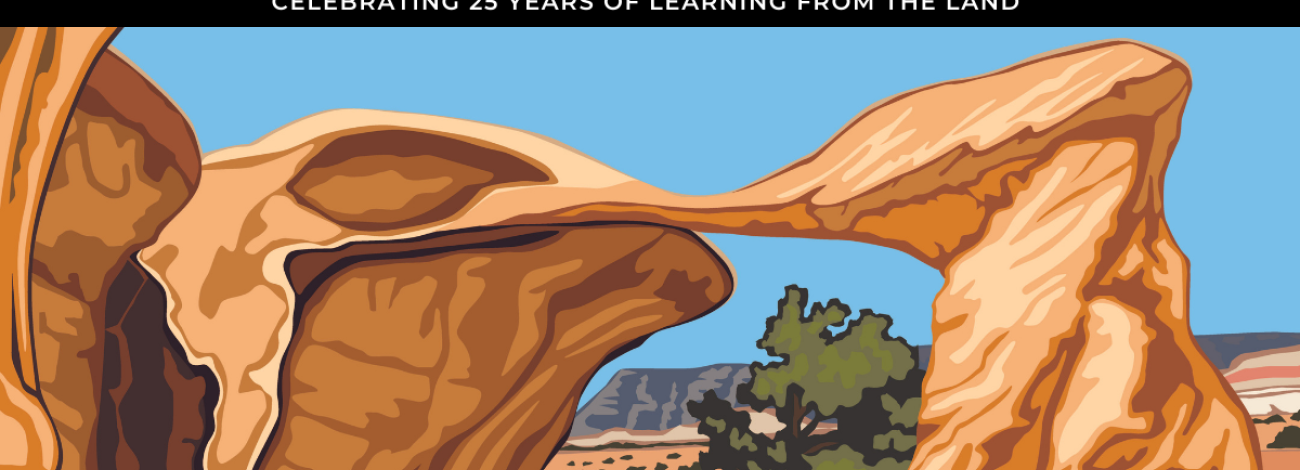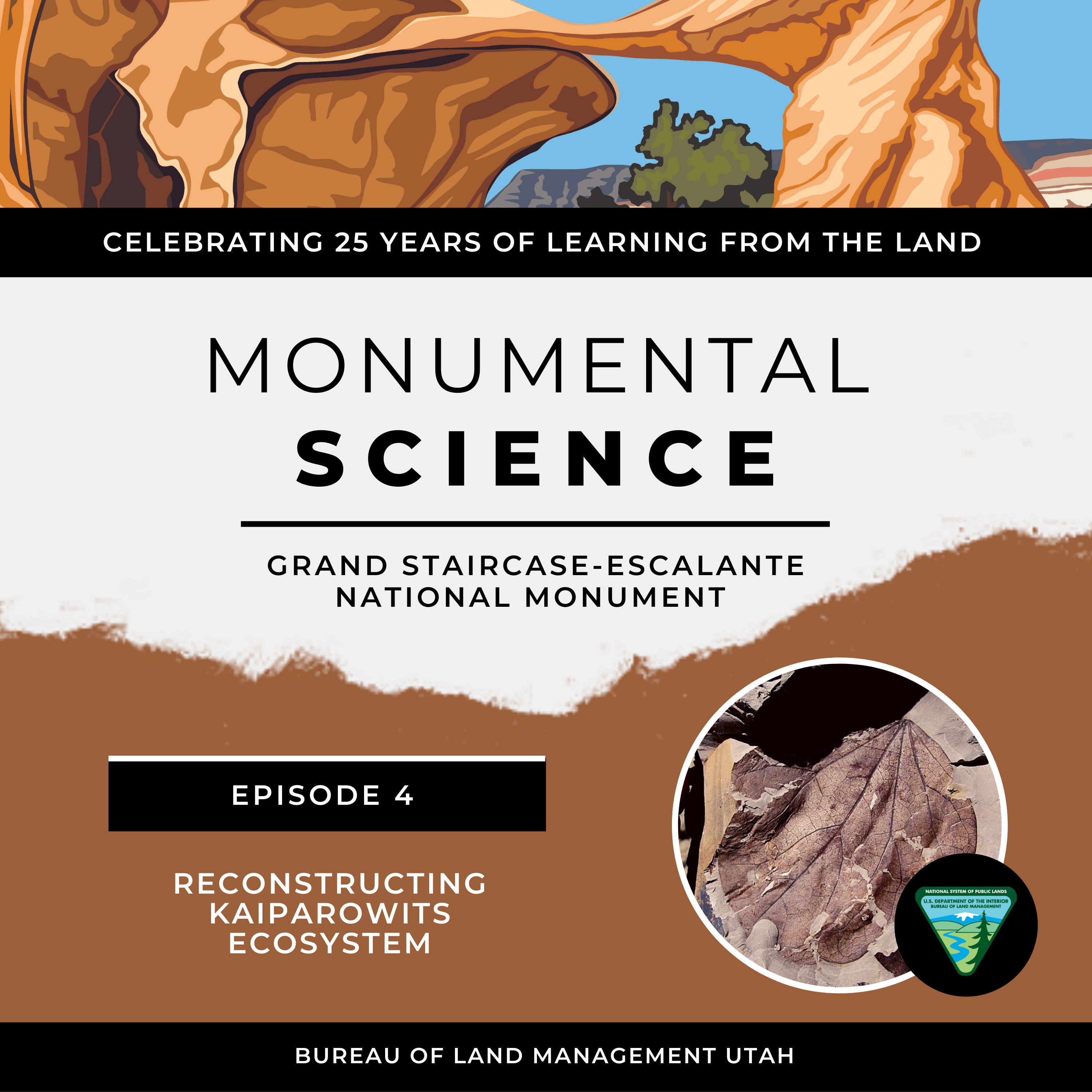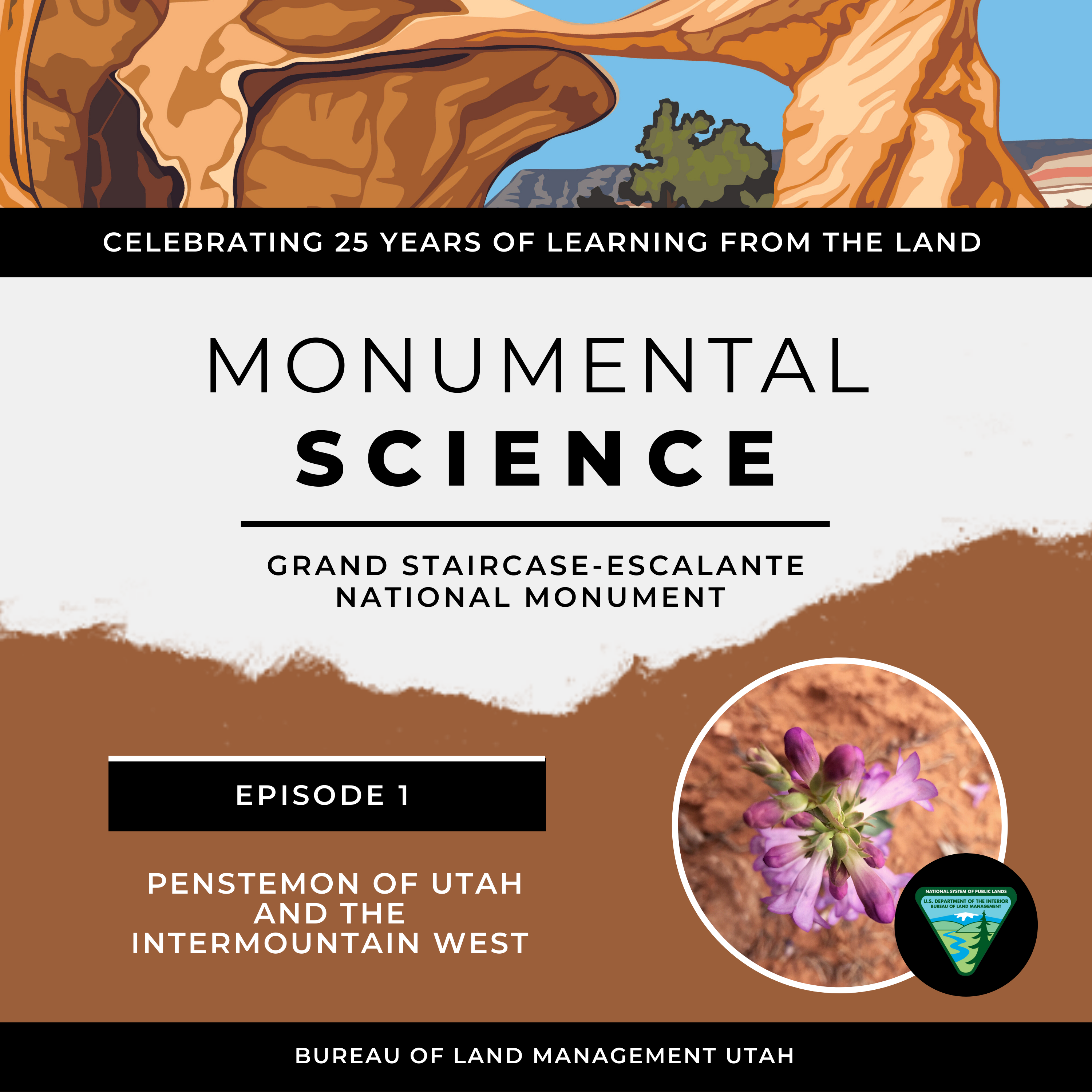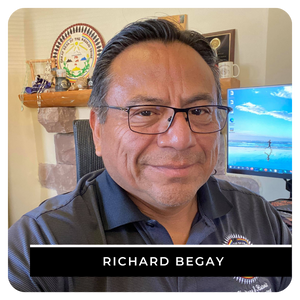
GRAND STAIRCASE-ESCALANTE NATIONAL MONUMENT: 25TH ANNIVERSARY
Monumental Science
Grand Staircase-Escalante National Monument (GSENM) celebrated its 25th anniversary as the first national monument managed by the Bureau of Land Management on Sept. 18, 2021. In 1996, the Presidential Proclamation 6920 helped ensure nearly 1.9 million acres would remain an ecological, scientific and cultural “living laboratory” and “working landscape” national monument located in south-central Utah, within the Colorado Plateau geographic region, where public lands are managed by the BLM, the National Park Service and U.S. Forest Service.
The GSENM continues to evolve as a place of cultural, paleontological, ecological and geographic discovery, as managers work to retain traditional resource values, while preserving important monument objects of value for the benefit of generations.
Audio Series:
- "Reconstructing Kaiparowits Ecosystems" - Guest Speaker: Sarah Augusta “Gussie” MacCracken

"Reconstructing Kaiparowits Ecosystems"
Dr. Sarah Augusta “Gussie” MacCracken, paleobotanist and National Science Foundation postdoctoral fellow, Department of Earth Sciences at the Denver Museum of Nature and Science, chats with Grand Staircase-Escalante National Monument Paleontologist Dr. Alan Titus about reconstructing Kaiparowits ecosystems from the bottom up and how scars on fossil leaves illuminate the diversity of ancient plants and insects on the Monument.
- "Dinosaur Discoveries from Laramidia's Southern Frontier" - Guest Speaker: Dr. Joseph Sertich

"Dinosaur Discoveries from Laramidia's Southern Frontier"
Dr. Joseph (Joe) Sertich, Curator of Dinosaurs at the Denver Museum of Nature & Science, and Grand Staircase-Escalante National Monument Paleontologist Dr. Alan Titus discuss research through 10 years of collaborative exploration of the monument and new dinosaur discoveries from Laramidia's southern Frontier.
- "Turtle Diversity at the National Monument" - Guest Speaker: Dr. Joshua Lively

"Turtle Diversity at the National Monument"
Dr. Joshua Lively, curator of paleontology at Utah State University Eastern Prehistoric Museum, talks with Grand Staircase-Escalante National Monument Paleontologist Dr. Alan Titus about his research on a new freshwater sea turtle from Grand Staircase-Escalante National Monument and reviews turtle diversity in the Cretaceous Kaiparowits Formation.
- "Penstemon of Utah and the Intermountain West" - Guest Speaker: Dr. Mikel Stevens

"Penstemon of Utah and the Intermountain West"
Dr. Mikel Stevens, Emeritus Professor of Plant Genetics and Plant Breeding at Brigham Young University, chats with Grand Staircase-Escalante National Monument Paleontologist Dr. Alan Titus about his penstemon research on the Monument.
- Navajo Cultural Connections to the Southern Utah Landscape
-

Richard Begay - Tribal Historic Preservation Officer, Navajo Nation
Richard Begay worked on the Navajo Indian Reservation in Arizona, New Mexico, and Utah as a field archaeologist and later as an ethnologist for various projects, including the Bureau of Reclamation’s Glen Canyon Environmental Studies efforts to document Navajo history of the Grand Canyon region.
Disclaimer: The views and opinions expressed in this audio message are those of the author and do not necessarily reflect the official policy or position of the Bureau of Land Management.
History
Within its boundaries, spectacular cliffs and terraces, rugged terrain, slot canyons, bridges and arches serve as a backdrop to national and state scenic byways and remote roads, the Old Spanish National Historic Trail, outstanding natural and wilderness study areas, and about 234 miles of river segments eligible for congressional designation into the National Wild and Scenic Rivers system. Five eco-zones from desert to subalpine coniferous forests support wildlife and plant species, and host grazing, ranching, and other productive uses. Fossils found generated paleontological information that ranks GSENM as among the world’s most scientifically significant repositories from the dinosaur era—just as cultural artifacts, rock art, campsites, masonry and pithouses, and granaries demonstrate the rich history of ancient inhabitants.
On Dec. 4, 2017, Presidential Proclamation 9682 reduced the size of GSENM to 1,003,863 acres. The lands removed created the BLM-administered Kanab-Escalante Planning Area (KEPA). Today, GSENM’s lands are managed as three units—Grand Staircase, Kaiparowits and Escalante Canyons.
Virtual Art Show
Explore the virtual art show and discover the incredible beauty across the diverse landscapes of Grand Staircase-Escalante National Monument.
Artist in Residence
The Artist in Residence program provides artistic and educational opportunities to foster a deeper understanding and dialogue of the natural, cultural, and historic resources in Grand Staircase-Escalante National Monument (GSENM). The program promotes the value of National Conservation Lands and their connections to the local communities. Residencies allow artists to pursue their work in stimulating environments and share it with the public.
Biography: Artist-in-Residence Gunther Haidenthaller grew up in sight of the Alps in Austria. He played among 200-year-old Roman ruins and immigrated to the United States at age 6. He took art classes in junior high and high school, learning to ski, rock climb, ice climb, fly fish, skydive and whitewater kayak as an adult. Studying illustration and advertising design at Utah State University before he returned to Austria for mission work, Haidenthaller spent nearly 30 years devoted to graphic design, art direction, offset and screen painting, and taking photographs, and 10 years as a soccer administrator. Now he paints full time, “haunted by the ethereal, dreamlike quality of light” that he expresses in his artwork, as resident artist at GSENM.
View the art collection by Günther Haidenthaller
Science Presentations
This science video series will take you inside the monument for a glimpse across the landscape. In this series, we hope you learn more about some of the contributions to conservation that a few of our BLM and partner researchers have uncovered in this place many affectionately call their living laboratory.
- Utah's Hidden Ecosystems: Grand Staircase-Escalante National Monument I Presented by Dr. Randall Irmis
- Jewels of The Desert - Bees: Grand Staircase-Escalante National Monument I Presented by Dr. Olivia Carril
- Penstemon of Utah: Grand Staircase-Escalante National Monument I Presented by Dr. Mikel Stevens
- Fresh-Water Sea Turtle: Grand Staircase-Escalante National Monument I Presented by Dr. Joshua Lively
- Breaking Down Navajo Sandstone: Grand Staircase-Escalante National Monument I Presented by Dr. David Loope
- Enigmatic Traces of Sacred Water: Cup and Channel Petroglyphs of the Far West Grand Staircase-Escalante National Monument I Presented by Michael L. Terlep




